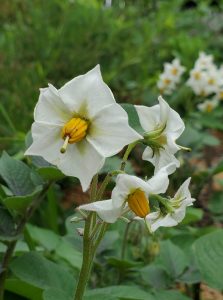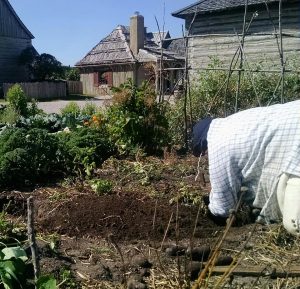

Although most food was purchased and shipped to Michilimackinac, local gardens provided an important source of fresh produce for the community’s 18th century residents. We currently maintain over 5,000 square feet of gardens at Colonial Michilimackinac, guided by a variety of historic sources. One of the most interesting 18th century documents at our disposal is the journal of the Michilimackinac merchant John Askin, who recorded his garden activities in 1774 and 1775. In this semi-regular series, we’ll examine some of the plants Askin (or more likely the free and enslaved employees working for him) was cultivating at Michilimackinac in the 1770s.
Askin really liked growing potatoes. They are the most-mentioned vegetable in his journal. If he wrote about his farm or garden, it was highly likely that he was writing about potatoes.
They are first mentioned on April 27, 1774 when he “Sett potatoes at the farm” and once more the next day “sett potatoes at the farm.” The next month he planted more potatoes on four different occasions. It appears they grew well over the summer, and he was able to dig most of them on the 8th of November just a couple of days after a 4-inch snowfall. We finally see the last mention of in 1774 on November 14 when he “dug the last of my potatoes.”
With one season of cultivation under his belt, Askin decided that he could perhaps get a better potato crop if he changed the ways in which he was planting them. In 1775 he decided to try some experiments. Experimenting in the garden or on the farm is something that growers love, no matter the time period. In the 18th century there was a huge interest in how things grew and the various ways of improving crops. Gardeners around the world were developing new methods for growing plants and it is no surprise that it was happening at Michilimackinac as well.
On August 29, 1775, Askin wrote that the potatoes were put into the ground “with a little dung in the holes.” This is different from his previous entries where he does not mention planting with any sort of manure at all. Gardeners like Philip Miller wrote pages and pages about the worth of various sorts of animal and vegetable manure in the 18th century. Even George Washington experimented with various types of muck to see which would grow the best beans, etc. While Askin does not tell us the sort that he used, he did have a small number of cows and horses. Both animals produce excellent dung with superb growing qualities.


He also “Set three hills of potatoes near the pease” on October 28. In each of these hills he employed a different method of planting. In the first hill he put “one potatoe cut in 3,” and in the second and third hills he put “3 whole potatoes” about “4 inches deep.” Modern gardeners still debate over the necessity and results of planting potatoes whole versus cutting them into pieces. It seems like cutting the potatoes can potentially leave the pieces more vulnerable to disease. However, if you have a small amount available to plant you will get more by dividing the tubers that you do have. Unfortunately, John himself did not tell us which side of the debate he stood on after his experiments.
No matter how you plant them, potatoes are a welcome addition to any garden. They are an easy and reliable vegetable to grow whether it is 1774, 1775 or 2020. The next time you come to Colonial Michilimackinac see if you can spot the potatoes growing in our gardens in the same way they were being grown nearly 250 years ago. Check back for future entries about other parts of John Askin’s garden, and consider contributing to Mackinac Associates, which makes our gardens and many other activities possible.








